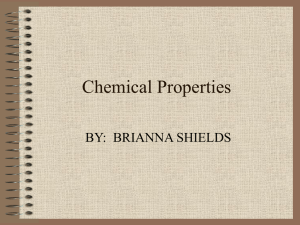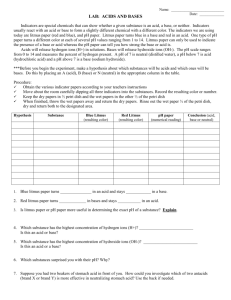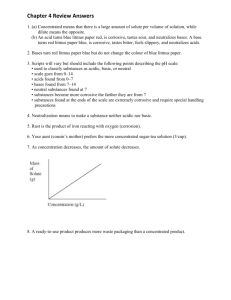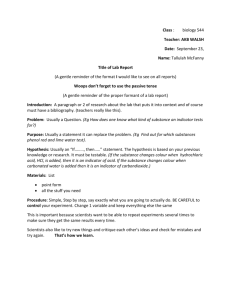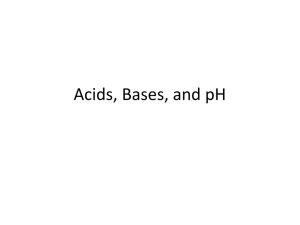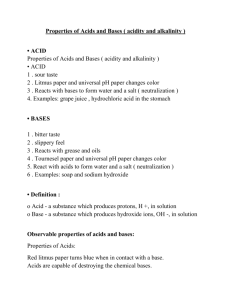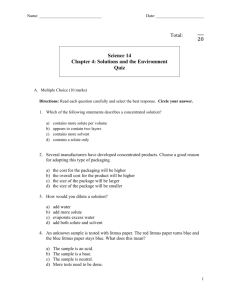Acids and Bases Lab: pH Indicators & Blood Plasma
advertisement
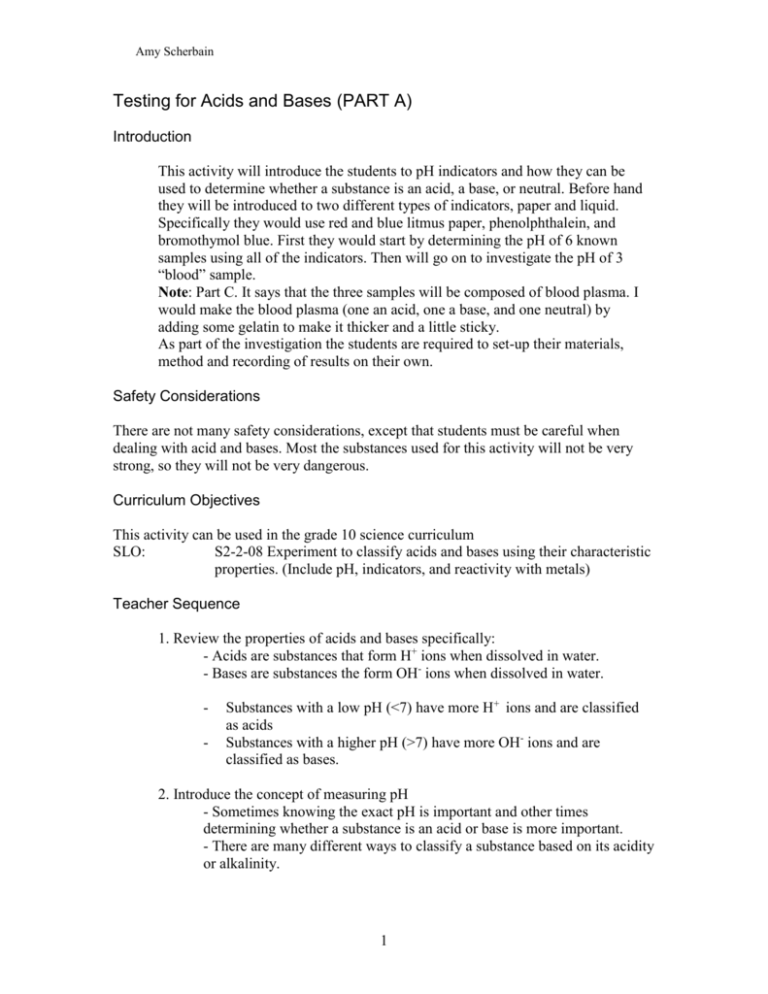
Amy Scherbain Testing for Acids and Bases (PART A) Introduction This activity will introduce the students to pH indicators and how they can be used to determine whether a substance is an acid, a base, or neutral. Before hand they will be introduced to two different types of indicators, paper and liquid. Specifically they would use red and blue litmus paper, phenolphthalein, and bromothymol blue. First they would start by determining the pH of 6 known samples using all of the indicators. Then will go on to investigate the pH of 3 “blood” sample. Note: Part C. It says that the three samples will be composed of blood plasma. I would make the blood plasma (one an acid, one a base, and one neutral) by adding some gelatin to make it thicker and a little sticky. As part of the investigation the students are required to set-up their materials, method and recording of results on their own. Safety Considerations There are not many safety considerations, except that students must be careful when dealing with acid and bases. Most the substances used for this activity will not be very strong, so they will not be very dangerous. Curriculum Objectives This activity can be used in the grade 10 science curriculum SLO: S2-2-08 Experiment to classify acids and bases using their characteristic properties. (Include pH, indicators, and reactivity with metals) Teacher Sequence 1. Review the properties of acids and bases specifically: - Acids are substances that form H+ ions when dissolved in water. - Bases are substances the form OH- ions when dissolved in water. - Substances with a low pH (<7) have more H+ ions and are classified as acids Substances with a higher pH (>7) have more OH- ions and are classified as bases. 2. Introduce the concept of measuring pH - Sometimes knowing the exact pH is important and other times determining whether a substance is an acid or base is more important. - There are many different ways to classify a substance based on its acidity or alkalinity. 1 Amy Scherbain - Indicators are used to classify substances. Indicators are organic substances that change colours at certain pH values. - There are paper indicators (litmus paper) and liquid indicators (phenolphthalein) The following is how some paper indicators change colour in the presence of acids and bases: Blue litmus paper in ACID turns RED Blue litmus paper in BASE or WATER stays BLUE Red litmus paper in ACID or WATER stays RED Red litmus paper in BASE turns BLUE In order to determine whether a substance is an acid or base you must use both red and blue litmus paper. This is mainly to determine if the substance is neutral because the paper will stay the same colour in both. Liquid indicators also change colours in similar ways. Here are two liquid indicators and how they change colour in acids or bases: Phenolphthalein (colourless) and BASE turns PINK Bromothymol blue (blue) and ACID turns YELLOW In this investigation students will see how known acids and bases react with the four indicators and then classify three unknown solutions using a medical model. 2 Amy Scherbain Testing for Acids and Bases (PART B) Introduction The pH of a substance is used to determine the strength of an acid or a base. Sometimes determining the exact pH of a substance is not always relevant or practical. In most cases determining whether a substance is an acid or base is more important. Indicators are used to determine whether substances are acids, bases, or neutral. Indicators are substances that change colour at certain pH values. There are a wide variety of pH indicators that include liquid indicators (phenolphthalein) and paper strips (litmus paper). In class we looked at four different types of indicators. As a review this is how they change colour in different substances. Blue litmus paper + ACID turns RED Blue litmus paper + BASE or NEUTRAL stays BLUE Red litmus paper + ACID or NEUTRAL stays RED Red litmus paper + BASE turns BLUE Phenolphthalein (colourless) + BASE turns PINK Bromothymol blue (blue) + ACID turns YELLOW Materials HCl NaOH HNO3 NH3(ammonia) Blue & Red Litmus Paper Glucose Solution Droppers H2SO4 Spot Plates Phenolphthalein & Bromothymol blue 3 Amy Scherbain Procedure 1. Using a dropper, collect 3-4 drops of each of the 6 chemical substances on the side bench and place them in a separate depression on your spot plate as shown in the diagram HCl Glucose NaOH NaCl H2SO4 NH3 . Figure 1. Spot plate with different chemical substances 2. To each chemical test whether it is an acid or a base by using both blue and red litmus paper. Record your results in Table 1. 3. Now add 1-2 drops of phenolphthalein to each chemical. Record and resulting colour changes in Table 1. 4. Discard of all the chemicals in the sink and clean the spot plate. Make sure it is completely dry. Repeat step 1. 5. Now add 1-2 drops of bromothymol blue to each chemical. Record all resulting colour changes in Table 1. 6. Determine whether each chemical is an acid, base or neutral based on your results. 4 Amy Scherbain Results Table 1. Results of acid-base testing Chemical Red Blue Phenolphthalein Bromothymol Litmus Litmus Blue HCl NaOH NaCl Glucose H2SO4 NH3 Summary Questions 1.) Which of the chemicals are ACIDS? 2.) Which of the chemicals are BASES? 3.) Which of the chemicals are NEUTRAL? 5 Acid, Base, or Neutral? Amy Scherbain Testing for Acids and Bases (PART C) Introduction As most of you know blood is a very important part of the human body. It is the organ that circulates nutrients, oxygen, and other molecules to all the areas of the body. If we did not have blood we would not survive. Because blood is so important its pH must remain constant at all times. If the pH increases or decreases significantly a person can become very sick. For this reason there are many ways that your body makes sure that the pH stays around 7.4 at all times. Because 7.4 is so close to 7 it is considered neutral. If the pH of the blood increases it is known as alkalosis and if it decreases it is acidosis. There are three components that make up the blood. They are red blood cells, white bloods cells, and blood plasma. The blood plasma is composed of many different substances some of which contribute to the pH of blood. In this activity you will be given 3 different blood plasma samples. (Don’t worry, they are not real!!). You will have to design an experiment to determine the healthy sample and the two that are from patients that are ill (alkalosis and acidosis). The three samples that are provided are: Sample A Sample B Sample C You must think about what materials you will need, how you are going to perform the experiment, and how you will organize your data. You will hand in your method, observations and results, and the classification of each of the samples. You can complete all your work in the space provided. 6 Amy Scherbain Materials Note: You do not need to use all the indicators you have been shown in class. However, if you don’t use all four you must indicate which one(s) you are not using and why. Method (What are you steps that you will take to determine the identity of the 3 samples?) Observations (How are you going to record your data? i.e. chart, table, graph, etc.) 7 Amy Scherbain Results / Conclusion Extension Questions 1.) Why is it that you need to use both red and blue litmus paper when testing for acids and bases? 2.) Why should more than one indicator be used when trying to determine whether a substance is an acid, base, or neutral? What problems may result from using just 1 indicator? 3.) Name 2 advantages that litmus paper has over liquid indicators. 4.) What type of indicator would you use to determine the pH of an opaque (non-clear, cloudy) substance? Explain. 8
